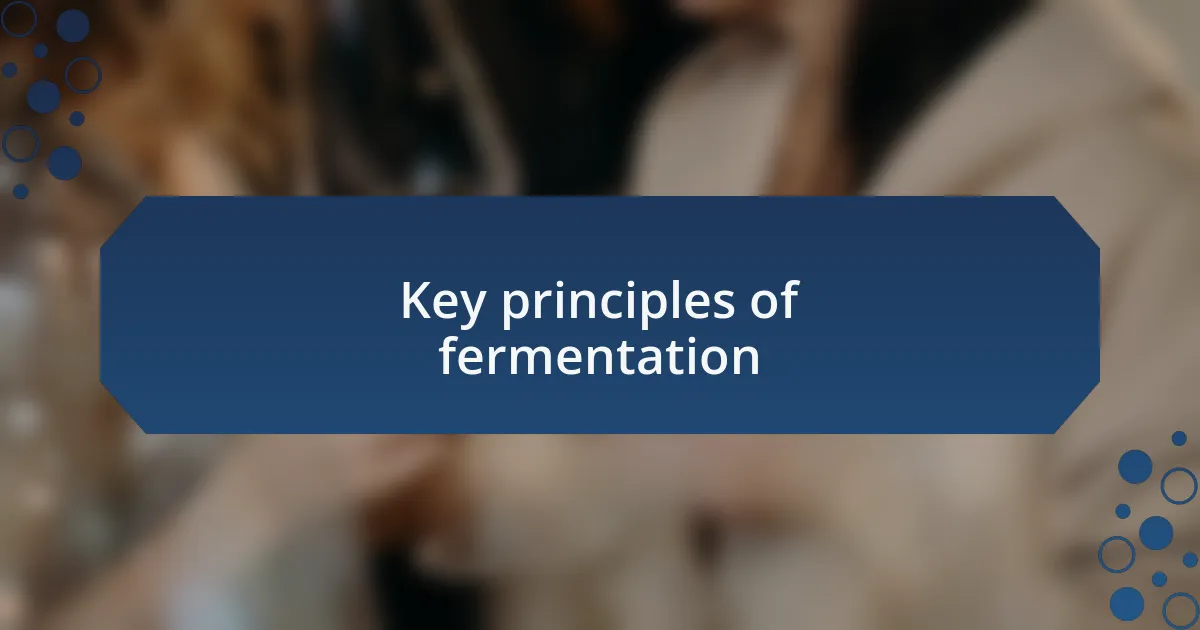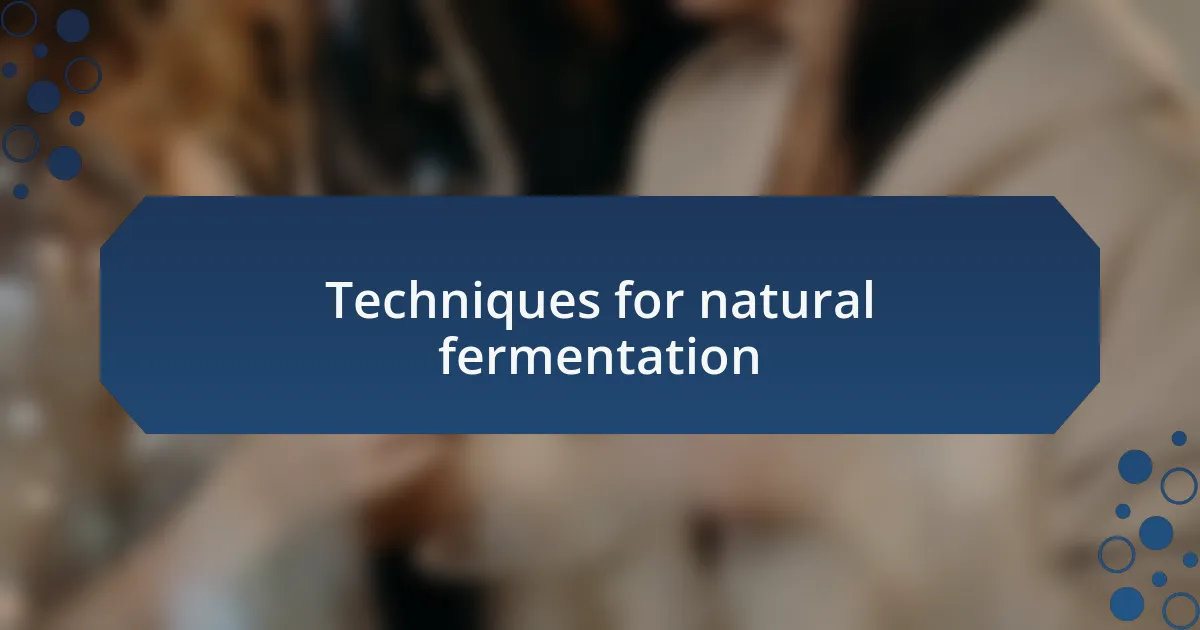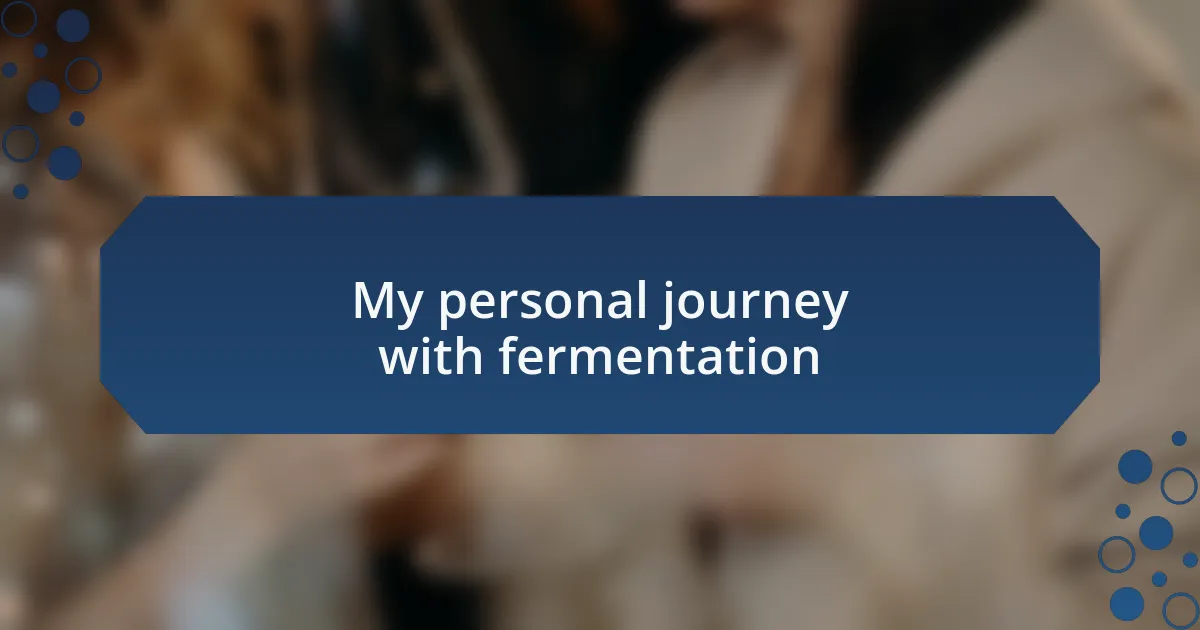Key takeaways:
- Organic wine production enhances grape quality through sustainable practices, avoiding synthetic chemicals.
- Natural fermentation showcases unique terroirs and leads to complex flavors due to wild yeast diversity.
- Key principles include temperature control and fermentation duration, impacting wine’s flavor and complexity.
- Challenges in fermentation, like temperature variability and spoilage risks, require resilience and adaptability.

Understanding organic wine production
Organic wine production is all about enhancing the quality of the grapes without synthetic fertilizers, pesticides, or herbicides. I remember touring an organic vineyard and being struck by how vibrant the plants looked. It solidified my belief that healthy soil translates directly into better wine. Have you ever tasted a wine that felt distinctly alive? That vitality often stems from the organic methods employed in its creation.
The process of organic wine production focuses on sustainable practices that respect both the land and the wine drinker. As I wandered through the vineyard, I could sense a connection between the earth and the vines. It made me think: how often do we consider the journey our beverages take before reaching the glass? This thoughtful cultivation leads to wines that not only taste better but also tell a story of their environment.
Organic viticulture enables winemakers to harness natural fermentation, highlighting the distinct characteristics of each wine. When I enjoy a glass of organic wine, I often ponder the complexities behind its flavors—each note a testament to the careful, hands-on approach of the winemaker. Isn’t it fascinating how something so intricate can stem from a commitment to nature and authenticity?

Benefits of natural fermentation
Natural fermentation offers numerous benefits that enhance the character of organic wines. First and foremost, it allows the unique terroir to shine through. I recall tasting a Pinot Noir that vividly expressed the essence of its vineyard—each sip was like a conversation with the earth itself. Have you ever noticed how some wines echo their surroundings? This is one of the magic effects of natural fermentation.
Another significant advantage is the diversity of flavors that develop during the process. Wild yeast strains, often present on grape skins, introduce a range of complex aromas and tastes that cultivated yeasts simply can’t replicate. I once savored a natural wine that unfolded in my glass like a layered story, revealing new nuances with each sip. Isn’t it remarkable how such unpredictability can lead to a personal connection with each bottle?
Moreover, natural fermentation tends to produce wines with greater depth and authenticity. These wines often resonate more with the drinker, evoking emotions and memories tied to their origins. I find a certain joy in sharing a bottle made through this process, knowing it embodies not just the winemaker’s skill but also a raw, untamed essence of nature. Do you feel that connection when you sip on a wine crafted this way? It’s an experience that can’t be easily forgotten.

Key principles of fermentation
Fermentation is fundamentally about transformation. It begins when yeast consumes the sugars present in grape juice, creating alcohol and carbon dioxide as byproducts. I vividly remember the first time I witnessed this process in a vineyard; the bubbling must in the fermentation tank seemed alive, brimming with potential, reminding me that winemaking is as much art as it is science. Isn’t it fascinating that such small organisms play a pivotal role in shaping the final product?
Another principle is the importance of temperature control. I’ve found that cooler temperatures can slow down fermentation, allowing for a more gradual development of flavors, almost like a slow dance between the yeast and the juice. At one winery, I experienced a wine that was deliberately fermented at a lower temperature, resulting in a crisp, clean taste that was utterly refreshing. How does temperature influence your perception of flavors, I wonder?
Lastly, the duration of fermentation significantly impacts the outcome. Some winemakers opt for a shorter fermentation, emphasizing freshness and vibrancy, while others believe in extended maceration to extract more tannins and complexity. During a tasting event, I was struck by the difference; the shorter-fermented wine felt like a summer breeze, light and lively, whereas the longer-fermented one had a depth that told a story of time and patience. Which style resonates with you more—the immediate pleasure or the profound layers of taste?

Techniques for natural fermentation
Techniques for natural fermentation can vary greatly, and one approach that I’ve come to appreciate is the use of wild yeast. Unlike commercial yeasts, wild yeast comes naturally from the vineyard environment. I distinctly remember the first time I encountered a wine fermented this way; it had a wild, earthy character that felt like a true expression of the terroir. Isn’t it amazing how nature can lend such unique qualities to a wine?
Another technique involves the use of ambient temperatures. In my experience, allowing the must to ferment in a naturally cool cellar can encourage a slower fermentation process. I once visited a winery that utilized this method, and I was amazed at how the slow pace unfolded complex flavors over time. Have you ever tasted a wine that opened up beautifully after some time in the glass? That nuance often comes from gentle, leisurely fermentation.
One cannot overlook the significance of grape skin contact during fermentation. This method not only imparts color but also essential tannins and flavor complexity to the final product. I remember tasting a skin-contact white wine that was rich and savory, far removed from the usual crisp whites I was accustomed to. It sparked a question in my mind: how much more can we discover about our palate when we embrace these unconventional techniques?

My personal journey with fermentation
My first encounter with fermentation was serendipitous. I was experimenting with homemade pickles, and as I watched the transformation from fresh cucumbers to tangy delights, I felt an undeniable connection to nature. The bubbling process was thrilling—it was like witnessing a secret dance of microorganisms bringing life to ordinary produce. Isn’t it fascinating how something so simple can create profound flavors?
As I ventured deeper into fermentation, I decided to try my hand at brewing my own beer. I vividly recall the moment I cracked open my first bottle, the fizzing sound almost a crescendo of my efforts. The first sip was a mix of triumph and surprise; the flavors were imperfect yet uniquely mine. This experience taught me that fermentation often embraces imperfection, leading to growth in unexpected ways. Have you ever stumbled upon something you created and found joy in its flaws?
Finally, my journey led me to natural wine. Once, while at a local tasting event, I was captivated by a bottle that hadn’t been filtered. Its cloudiness intrigued me, hinting at a story behind every sip. I couldn’t help but wonder how many hands and how much time shaped this wine. It was a moment of revelation, reminding me that the essence of fermentation lies not just in the process but in the narratives and connections we forge through it.

Challenges faced in fermentation
Fermentation is a delicate balancing act, and I’ve faced my share of hurdles along the way. One of the most perplexing challenges is temperature control. I remember a batch of wine that I was particularly excited about; I meticulously monitored every step. However, one sudden heat wave led to a stuck fermentation, leaving me with a batch that lacked the vibrant character I envisioned. How often do we underestimate the environmental factors affecting our creations?
Another obstacle that often arises is wild yeast variability. In my experience, this unpredictability can yield fascinating yet inconsistent results. I once left a batch to ferment naturally, and the resulting flavors were a beautiful surprise but completely different from what I had anticipated. It made me reflect—shouldn’t the beauty of fermentation come with a little chaos? Navigating these inconsistencies can be frustrating, yet they often lead to the most memorable creations.
Moreover, the risk of spoilage is ever-present. I vividly recall a moment when I detected off aromas during a fermentation process; my heart sank. It’s in those instances of uncertainty that I found myself questioning my methods and instincts. How do we balance the desire for natural processes with the need for quality? Embracing these challenges ultimately taught me resilience and adaptability, essential traits for anyone passionate about fermentation.